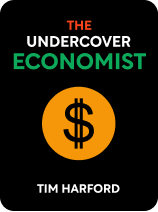

This article is an excerpt from the Shortform book guide to "The Undercover Economist" by Tim Harford. Shortform has the world's best summaries and analyses of books you should be reading.
Like this article? Sign up for a free trial here .
What are negative externalities? What do governments do in an attempt to control them?
Negative externalities are costs incurred by non-involved parties as a result of an economic transaction. To prevent negative externalities, governments may impose externality charges.
This article takes a look at negative economic externalities and how governments determine how to levy them on the consumer.
Understanding Economic Externalities
To understand what negative externalities are, let us first understand how a free market economy works. In the most basic form of a free market, everyone goes about their lives, selling and buying goods, without any regard for how their actions affect others. Often, though, the actions of one buyer or seller can affect a third party, who’s not involved in the sale of goods or services. This is called an externality.
Externality charges are the best way to disincentivize an activity that harms others because people will act in self-interest. When the government levies externality charges on activities that are selfish and harm others, it’s usually not in your best interest to continue to pursue the harmful activity. Thus, fewer people pursue harmful activities and there are fewer negative externalities.
Charging Negative Externalities
Let’s use the example of drivers to expand on externalities and externality charges. Cars clog up all of the biggest and best cities in the world. The air pollution that results from this literally kills some bystanders—estimates in the U.S. suggest that 15,000 people die a year from air pollution that’s caused by burning diesel fuel in car engines. In addition to the worst possible externality, death, there are lots of others that come from cities being so clogged by cars, including huge time delays because of traffic that slows down public transportation like buses. Then, there’s the noise, which can drive people out of a city entirely or discourage them from walking so much, which ironically leads to more cars on the streets and more noise pollution.
In other words, lots of people are benefiting from driving themselves. But by benefiting themselves, they’re also harming others. This complicates the idea that everything we do in the market helps create a perfectly efficient system. (If it were perfectly efficient, drivers would have to pay the people whose lives they are making more difficult.)
Drivers do end up paying taxes for having a car. Gas taxes, for example, are high all around the world, and in a lot of places, drivers pay a tax for the privilege of having a car in the form of a license fee.
Charging money for these externalities is a balancing act. We want to keep letting people do things they like, so we don’t want taxes on externalities to be too high. But we also want to make sure that people aren’t destroying the lives of those around them by doing what they want. Essentially, when figuring out externality taxes, we should attempt to imitate perfectly efficient markets as much as possible. We want the total cost to everyone else to be exactly equal to the benefit for one person.
Levying externalities is also situation-dependent. Charging people to drive at busy times in the city is a redistributive tax in the United Kingdom, where poorer people don’t drive. But in the United States, where poor people drive a lot, they end up paying a significantly higher percentage of their income on gas than rich people do. However, even in this case, it’s better to levy taxes on each trip into the city than it is to have one up-front tax. This way, poorer people can reduce their tax burden by choosing not to drive in the city as much, rather than having to pay a big tax every year and then feeling as if they need to justify it by driving in the city a lot.
Ultimately, externality charges are bound to be controversial. They are not an exact science, and some will argue that they are not tough enough, while others will argue that they are too tough. It is clear, though, that externality charges are the best way to disincentivize an activity that harms others. People will act in self-interest, and if we levy externality charges on activities that are selfish and harm others, it will be increasingly less in their self-interest to continue to pursue the harmful activity.

———End of Preview———
Like what you just read? Read the rest of the world's best book summary and analysis of Tim Harford's "The Undercover Economist" at Shortform .
Here's what you'll find in our full The Undercover Economist summary :
- How to think like an economist
- How to use principles like scarcity, price targeting, the stock market, and game theory to make better decisions every day
- Why the economy is mostly about people, not complex math, graphs, or jargon






